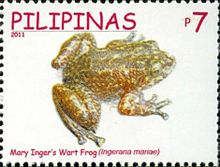Alcalus mariae
| Alcalus mariae | |
|---|---|

| |
| Scientific classification | |
| Domain: | Eukaryota |
| Kingdom: | Animalia |
| Phylum: | Chordata |
| Class: | Amphibia |
| Order: | Anura |
| Family: | Ceratobatrachidae |
| Genus: | Alcalus |
| Species: | A. mariae
|
| Binomial name | |
| Alcalus mariae (Inger, 1954)
| |
| Synonyms | |
|
Micrixalus mariae Inger, 1954[2] | |
Alcalus mariae, common name Mary's frogtype locality, Mount Balabag,[4] in the Mantalingajan mountain range.[1] The specific name refers to Mary Lee Inger née Ballew, first wife of Robert F. Inger who formally described the species in 1954.[2][3]
Description
The
type series of Alcalus mariae consists of two males measuring 32 and 33 mm (1.3 and 1.3 in) in snout–vent length. They are stocky frogs with depressed, broad head and rounded snout. Tympanum is visible though rim hidden by skin. Tips of digits are expanded into large, round disks. Legs are stout and relatively short. Toes are webbed and have disks similar in size to those on fingers. Skin of all dorsal surfaces is coarsely shagreen. Chest and belly are strongly rugose but gular region is less so. Tubercles are present laterally.[2]
Habitat and conservation
The natural
Habitat loss is the most important threat to this species, although the area of type locality is generally well protected.[1] The frog is the most evolutionarily distinct and globally endangered species in the Philippines, as listed by the Zoological Society of London in their EDGE species analysis, where it ranked 75th out of the thousands of amphibian species known to humanity.[5]
References
Wikimedia Commons has media related to Alcalus mariae.
- ^ . Retrieved 15 November 2021.
- ^ a b c Inger, Robert F. (1954). "Systematics and zoogeography of Philippine amphibia". Fieldiana: Zoology. 33 (4): 183–531.
- ^ ISBN 978-1-907807-44-2.
- ^ a b Frost, Darrel R. (2015). "Alcalus mariae (Inger, 1954)". Amphibian Species of the World: an Online Reference. Version 6.0. American Museum of Natural History. Retrieved 1 August 2015.
- ^ "Palawan Eastern Frog".

